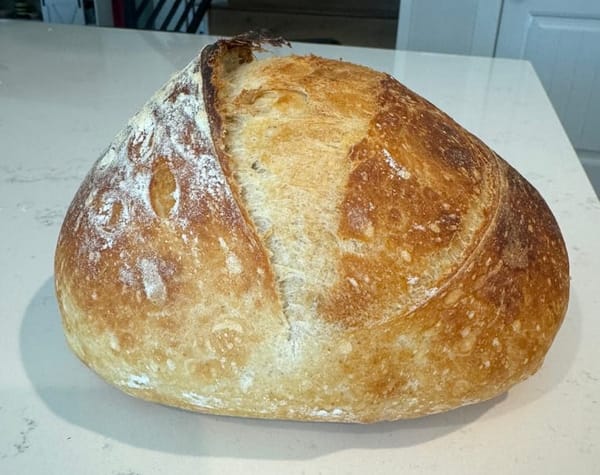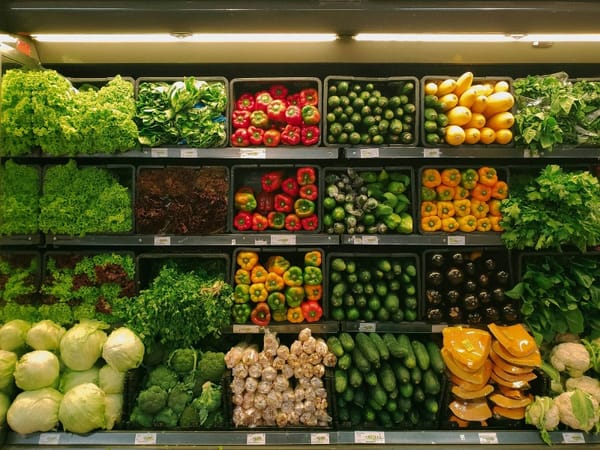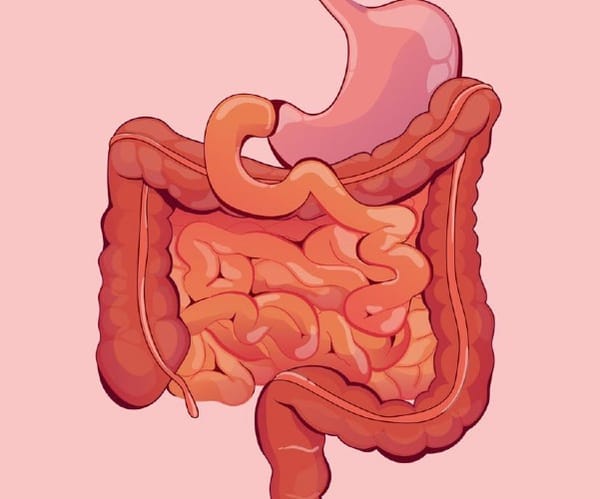The Gut Microbiome 101

Introduction
Over the past year or so I've been hearing more and more about this concept of "gut health" and more specifically the "gut microbiome". Based on the fact that I often struggled with stomach aches, bloating, and indigestion, I decided to look deeper into this vague subject hoping that it would hold the solution for my gastrointestinal issues. I listened to a lot of podcasts, scrolled through some scientific journals, and most importantly read the book 10% Human by Alanna Collen. Here is what I learned...
What Is It?
The human microbiota refers to the bacteria, yeasts, viruses, fungi, and parasites that live inside of us. A majority of the human microbiota resides in the large intestine in the form of bacteria. The average colon is home to an estimated 30 trillion bacteria cells, which outnumbers total human cells in the body.
If there are more bacteria cells living in our colon than total human cells in our body, these tiny microbes must be of some significance to us right? Well as it turns out, the state of our gut bacteria may be the number one indicator of overall health because they carry out vital bodily processes that our human cells simply are not capable of.
Just as the DNA in human cells encrypt “instructions” that distinguish the roles and functions of different cell types, the DNA of our gut bacteria, AKA our gut microbiome, encrypts instructions that distinguish the roles and functions of different strains of bacteria. Lucky for us, most of the instructions encoded in healthy bacterial DNA allow the microbes to carry out vital processes including:
- Breaking down insoluble plant fiber
- Creating mucus to protect the lining of the gut wall
- Regulation of the immune system
- Creating precursor molecules for hormones like serotonin
Without the presence of gut bacteria, our bodies simply would not be able to carry out these processes, because our own DNA does not contain the necessary instructions. That’s why we’ve formed an alliance, or a symbiotic relationship, with the microbes in our gut. Think of it like outsourcing - a company might outsource their IT services because they don’t have the means to operate an IT department on their own. Humans are outsourcing microbial services because we do not have the means to carry out certain processes that bacteria can, such as digesting fiber.
As you can imagine, things go awry when neither our human DNA or our outsourced bacterial DNA possess the instructions necessary for certain bodily processes. It means these processes simply aren’t occurring, which triggers a cascade of confusion and chaos in the body. Take lactose intolerance for example. The breakdown of lactose requires an enzyme called lactase, which significantly declines in abundance as people age. However, a healthy gut microbiota would include a strain of bacteria called Lactobacillus, which has the ability to create lactase and therefore break down lactose into lactic acid - a molecule that can be used as fuel for cells. If the gut microbiota does not contain Lactobacillus or even sufficient amounts of it, then lactose from dairy goes undigested by both our human-made enzymes and our bacteria-made enzymes, causing bloating, gas, abdominal pain, and inflammation.
Unfortunately, most people in the developed world have bacterial microbiomes that are lacking in diversity and quality, meaning that they have very few strands of bacteria in their colon, and the majority of strands they do have are not ideal. If a thriving bacterial microbiome was a tropical forest, most of ours would look like the Sahara Desert.
There’s no denying that the gut microbiome is vital in carrying out functions that promote health and happiness, so where did things go wrong? How have we destroyed this symbiotic relationship we are supposed to have with our gut microbes? Sorry if you don’t like history, but I have a need to know how this gut microbiome crisis started, and that takes us back to the early 1900s.
From the Beginning
Before the 1950’s, the top causes of death were all related to infectious diseases: tuberculosis, sepsis, smallpox, pneumonia, and a multitude of gastrointestinal infections. For this reason, microbes like bacteria and viruses were viewed as villains. Throughout the first half of the 1900s, researchers and scientists worked diligently to put an end to these lethal diseases, eventually leading to the discovery and implementation of four significant mechanisms of destroying microbes: hygienic medical practice, water sanitation, vaccination, and antibiotics.
- 1875: Louis Pasteur introduced the current concepts of standard precautions and isolation to mitigate cross-transmission in hospitals
- 1908: Routine disinfection of drinking water began in New Jersey
- 1947: Influenza Vaccine Approved
- 1945: Penicillin made available over-the-counter
After these discoveries, life expectancy across the globe skyrocketed as previously lethal microorganisms no longer had easy means of transmission into the human body, and bacteria or viruses that did enter the body were hastily killed by a strong dose of antibiotics or antibodies created by vaccination.
The average life expectancy in 1900 was 31 years. By 2005, it had more than doubled to 66 years. Developed countries like the U.S. even saw life expectancies in the high 70’s.
This seems amazing right?! Before the antimicrobial revolution, people were dying from infectious diseases at a young age. After, people are living well into their 60’s while infectious disease is low on the list of causes of death.
Sure, it’s great to live in a world where an infection from a splinter won’t kill you, but this timeline of the war against microbes reveals another story. As the rates of infectious diseases plummeted during the 20th century, other diseases were silently on the rise. You probably don’t know anyone who has suffered from tuberculosis recently, but my guess is that every person in your life deals with at least one of the following:
- Type I or II Diabetes
- Obesity
- Autism
- Asthma
- Allergies
- Irritable Bowel Syndrome
- Acne, Eczema, or Psoriasis
- Arthritis
- Depression or Anxiety
Yes, our lives have graciously been extended thanks to this lack of exposure to microbes, but at what cost? People in the U.S. are living into their 80’s… but a majority of those years are spent battling achy joints, anxiety, stomach aches, skin disorders, and straight up misery.
If you look at the quantity of life since 1900, you might think we have reached the peak of health as a planet. If you dig a little deeper and look at the change in quality of life during that timespan, things are not going so well.
Perhaps we went a little overboard when deciding that all microorganisms are bad and should be eliminated from the human body entirely. We have not only rid ourselves of the bad bacteria that cause illness, but also the good bacteria that help us carry out the vital bodily processes that I mentioned before. Clearly, we are dealing with the consequences.
Where Does our Microbiome Come From?
Just as with human DNA, every single person possesses a unique combination of bacterial DNA. Although it can change overtime, the base of your microbiome is created at birth from exposure to the microbes within your mom’s vaginal canal or on her skin. Babies born vaginally tend to pick up critical microbes as they slide down the canal and shoot out into the world, while babies born via C-section miss out on exposure to these microbes and essentially start life with a dull microbiome.
Your microbiome is further affected by the type of nutrients you feed it immediately after birth - AKA breastmilk vs. formula. Exclusive and partial formula-feeding results in an increase of proinflammatory microbes and permeability of the gut lining. On the other hand, infants that are exclusively breast-fed display high quantities of gut-protective bacteria that have the ability to break down complex sugars found in breastmilk. Basically, the longer an infant is breastfed before being introduced to formula or cow’s milk, the stronger their gut microbiome will be.
By the time you are around two years old, your gut microbiome is already well-developed. However, it can be significantly enhanced or disrupted based on lifestyle choices such as early antibiotic use and levels of exposure to microbes.
As we’ve already addressed, antibiotics are great at doing their job - killing pathogenic bacteria. The problem is that these medications cannot distinguish between good and bad bacteria, so they kill everything in their path. Obviously, eliminating healthy bacteria strains from the body significantly disrupts the microbiome, especially in young children who are still in the stages of developing the base of their gut microbiota. Unfortunately, antibiotics are extremely over-prescribed in this age group due to the frequency of ear infections, runny noses, and other illnesses. Many of these conditions would resolve on their own without antibiotics, but doctors will prescribe them “just to be safe”. Although the intentions are in the right place, this overuse of antibiotics in young children has severe, lifelong consequences.
Antibiotics taken at any age have harmful effects on the gut microbiome and therefore overall health, but increased exposure to antibiotics during the first two years of life is associated with:
Yes, antibiotics save millions of lives every year and have played the biggest role in extending our lifespans, but they have also disrupted our microbiomes and may be the root cause for many autoimmune diseases developed during childhood. I think the solution here is to revert to using antibiotics how they were intended to be used: as a lifesaving measure for pathogenic infections.
The second factor that affects the development of your unique microbiome is your degree of exposure to the microbes themselves. As antibiotics work to kill our already established microbes, countless other agents are at work to make sure we are never exposed to these microbes in the first place. Constant hand washing, daily hot showers, cleaning with antibacterial solutions, and mask-wearing are all common practices in the modern world. While all are great for preventing illness, they also significantly limit our early exposure to microbes.
Not that anyone wants to be sick, but lack of exposure to microbes (even the bad ones) as a child leads to an immature gut microbiome that cannot function at full capacity. This immature gut microbiome leads to dysfunction of the immune system - which I will discuss in more detail later - and causes all sorts of unwanted issues further down the road. With that said, it comes as no surprise that children who grow up with siblings have a lower chance of developing allergies and autoimmune diseases than those who grow up in single-child households.
Now that we’ve addressed the significance and origin of the gut microbiome, let’s look more closely at how exactly it plays a role in 21st century illnesses like obesity, leaky gut, and autoimmune disease.
The Microbiome and Obesity
A lot of weight loss regimens rely on the concept of “calories in vs. calories out”, where burning a greater amount of calories than you consume is the gold standard for melting off the pounds. However, this method of losing weight rarely works, and oftentimes leads to relapses and episodes of binge-eating. That’s because this idea of tracking calories is not as black and white as everyone thinks.
According to the calories in vs. calories out method, 100 calories worth of oreos is equivalent to 100 calories worth of asparagus. If you look at what happens to the 100 calories in the body though, you will understand that not all calories are created equally. When you eat the 100 calories worth of oreos, you provide nothing of value to the microbiota in your gut - no fiber, no prebiotics, and no plant molecules. Therefore, the entirety of the 100 calories is readily absorbed into the bloodstream via the small intestine. This is true of most foods lacking in fiber, not just “junk foods”. On the other hand, the 100 calories worth of asparagus provides great value to the gut microbiota, including high amounts of fiber and prebiotics. Because the asparagus contains nutrients that the microbiota want and cannot be broken down by human enzymes, about 10-25% of the caloric intake is used in the large intestine as our gut microbiota break it into short-chain fatty acids and other beneficial molecules.
When you look at it this way, both the oreos and asparagus were 100 calories at the mouth, but while all of the calories from the oreo were absorbed into the bloodstream, only 75-90 calories from the asparagus were absorbed into the bloodstream. That may not seem like a huge difference, but adding those calories up over months and years can lead to significant discrepancies in weight. That’s why individuals who consistently eat diets high in processed foods and sugars become obese, while those who eat high quality foods rich in fiber and prebiotics stay lean.
On top of influencing the sheer number of calories being absorbed, our microbiome also plays a key role in fat storage. This starts with a molecule called lipopolysaccharide or LPS, which coats some species of bacteria living in the gut. LPS is harmless until it seeps into the bloodstream via a “leaky” gut lining, where it becomes toxic. Once in the blood, it travels to fat cells and causes inflammation while also preventing new fat cells from forming. The result is existing fat cells becoming inflamed and overfilled, rather than dividing while staying small. In a healthy individual, fat cells are banks of stored energy for times of famine. They continue to divide as they receive more energy (in the form of excess food) to be stored for the future. Individuals with poor microbiota health have fat cells that are incapable of dividing due to circulating LPS, therefore the existing fat cells get bigger and more inflamed, leading to weight gain and eventually obesity.
Knowing this information now, it seems that the obesity epidemic in the U.S. is mostly to blame on lack of awareness rather than lack of self control. The claim that all calories are created equal and that balancing calories in vs. calories out will negate weight gain is simply not true. Unfortunately, many people still try to fight weight gain by strictly limiting calories in while increasing calories out, but somehow the number on the scale continues to rise. They simply don’t understand that calories are not created equal, so the calories they eat are not only “worth more”, but are also wrecking their gut health and increasing circulating LPS. To this point, the best way to maintain a healthy weight is not by counting calories, but by eating calories that are beneficial to the gut microbiome. Before each meal, think not only about what you want to eat, but what your microbes want to eat as well.
The Microbiome and Leaky Gut
The lining of the gut is responsible for transporting necessary nutrients into the bloodstream while making sure toxins and pathogens cannot pass through. This is a tall ask considering that the intestinal lining is only one cell thick. Luckily, part of the symbiotic contract with our gut microbiome states that they will pick up the slack where our own systems are lacking.
To help with “security” of the gut lining, our microbiome creates a mucus layer that coats the cells lining the intestines and keeps bacteria and toxins from passing through the border. The main species of bacteria that produces this mucus is called Akkermansia muciniphila. It’s interesting to know that lean people have higher levels of Akkermansia while obese people have lower levels. This takes us back to LPS.
When Akkermansia is lacking in the gut, the gut lining does not have a strong mucus coating that prevents bacteria from crossing into the bloodstream. Therefore, the LPS that accompanies bacteria makes its way into the bloodstream and wreaks havoc on our fat cells.
*Quick tip: eating more fiber increases Akkermansia levels.
Another way that our microbiome helps secure the gut lining is through the synthesis of short-chain fatty acids (SCFAs). We talked about how our bacteria love to eat non-digestible polysaccharides found in plants, especially fiber. However, eating fiber is not only beneficial for our microbiome, but also for us, because our microbes take this fiber and turn it into short-chain fatty acids: acetate, propionate, and butyrate. These short-chain fatty acids have many uses in the body, but one of the most important is supporting the epithelial cells of the intestinal wall.
Butyrate in particular plays a key role in patching up holes in the gut lining that pathogens and toxins would otherwise sneak through. It does so by up-regulating the gap junctions between the epithelial cells that line the intestinal wall. Think of the gap junctions like wood panels on a picket fence. The fewer the wood panels, the more space for animals and critters to sneak through. With more wood panels, the gaps for these animals and critters to barge through are smaller and less accessible. The more butyrate our gut bacteria can produce from plant fiber, the more gap junctions we create in our intestinal epithelial cells, and the more secure our gut barrier becomes.
Without the mucus and butyrate produced by our microbiome, the lining of our gut barrier is not properly armed to keep toxins from entering the bloodstream. This condition is commonly known as Leaky Gut Syndrome.
When pathogenes and large particles from food continually seep into your bloodstream due to a leaky gut, obviously you’ll begin to experience things like abdominal pain, cramping, bloating, food sensitivities, and indigestion. However, another consequence of leaky gut is chronic inflammation due to the immune system constantly dealing with toxins crossing into the bloodstream from the gut. This chronic low-grade inflammation can lead to metabolic disorders over time such as obesity, type II diabetes, arthritis, fibromyalgia, and fatigue.
The best way to rid yourself of a leaky gut is by fostering a microbiome that will help protect your gut lining. In other words, you want to increase your mucus and butyrate-producing bacteria… which can be done by increasing fiber, plant foods, or even supplementing Akkermansia.
The Microbiome and The Immune System
The human immune system has evolved alongside bacteria since the beginning of the human species. It knows which microbes are beneficial and which ones cause harm, otherwise our immune systems would attack all bacteria and there would be no such thing as the microbiome to begin with.
Just like harmful pathogens, the bacteria that make up the microbiome have red flags on the surface that tell the immune system “I am a foreign invader!”... but unlike harmful pathogens, our friendly microbes share a password with the immune system that persuade immune cells to hold off the attack. The chemicals or “passwords” released from our friendly gut microbiota trigger the activation of an important component of the immune system called regulatory T cells (T-regs). These T-regs cells invoke a calming influence on the aggressive killer cells of the immune system, ensuring the survival of our friendly microbes.
When the gut microbiome is in a state of dysbiosis, there is a reduction in activation of the T-regs cells that calm the immune system. Without the T-regs holding them back, the killer cells in the immune system are unleashed to attack whatever they please, in some cases it’s our own cells they go after. The overactive cells sometimes go on to destroy pancreas cells, joint cells, nerve cells, and even the friendly gut microbes. This leads to autoimmune diseases like type I diabetes, rheumatoid arthritis, multiple sclerosis, and irritable bowel syndrome.
After learning the role that the microbiome plays in our immune response, it comes as no surprise that the majority of our immune system resides directly on the other side of our gut barrier. With that being said, the leaky gut that we just discussed is an obvious trigger for an overactive immune system.
When the gut lining becomes leaky, particles and pathogens that are supposed to be excreted end up in the bloodstream. The immune system perceives them as foreign invaders and launches an inflammatory attack to rid them from the body. After all, inflammation is the immune system’s response to perceived injury or infection.
If your gut is chronically leaky, then your immune system is chronically active, and you'll end up with chronic inflammation. The most common results of chronic inflammation include fatigue, depression, diarrhea/constipation, insomnia, and full body pain.
Fortunately, the easiest and most effective way to avoid an overactive immune system and chronic inflammation is to keep your microbes healthy. If you feed them properly, they will repay the favor by protecting your gut barrier and calming your immune cells.
What I’ve Learned
If you’re anything like I was 6 months ago, you probably had no idea that the bacteria living in your large intestine have such a significant impact on your health… which also means you probably haven’t been taking care of them. The good news is that unlike human DNA, bacterial DNA can grow and evolve overtime as they adapt to the environment they live in. Just being aware of the microbiome and its functions is the first step towards creating an environment where your own bacteria can thrive. I hope this post offers you that awareness and knowledge to be able to take the next steps towards a healthier microbiome and a healthier life.nNext week, I will discuss some of the diet and lifestyle changes I have implemented to improve my own gut health and fix my inflammation.
Thanks for reading!
Recommended Resources
10% Human by Alanna Collen!!!! (A beginner's guide to the microbiome)







